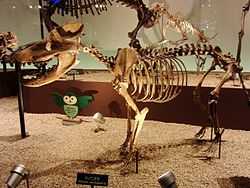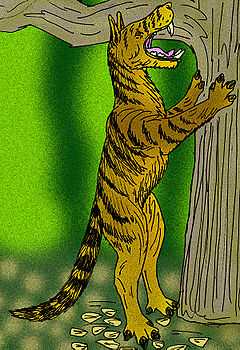Sinonyx
| Sinonyx Temporal range: Late Paleocene | |
|---|---|
 | |
| Skelton of Sinonyx jiashanensis at the National Museum of Nature and Science, Tokyo, Japan. | |
| Scientific classification | |
| Kingdom: | Animalia |
| Phylum: | Chordata |
| Class: | Mammalia |
| Order: | Mesonychia |
| Family: | Mesonychidae |
| Subfamily: | Mesonychinae |
| Genus: | Sinonyx Zhou et al. 1995 |
| Species | |
|
S. jiashanensis | |
Sinonyx ("Chinese Claw") was a wolf-like ungulate Mesonychid mammal from the late Paleocene of China that lived about 56 million years ago. It was an early primitive form of mesonychid, which some experts regard as a distinctive group of carnivorous condylarths, which gave rise to artiodactyls. Sinonyx was discovered in the Anhui province, China (30°54′N 120°54′E / 30.9°N 120.9°E, paleocoordinates 33°54′N 113°36′E / 33.9°N 113.6°E).[1]
Description
Sinonyx was about 1.5 m (5 ft) long, about the size of a modern grey wolf with a large elongated head, short legs and tiny hooves on all of its toes. It was built for stamina and strength and was well equipped to take care of itself by killing slower-moving prey or scavenging along sea shores. The tooth count was the primitive mammalian number (44) and the teeth were differentiated as are the heterodont teeth of today's mammals. The molars were very narrow shearing teeth, especially in the lower jaw, but possessed multiple cusps. The large skull had an extended occipital bone and large sagittal crest that contained a tiny brain. The large sagittal crest indicates a powerful bite, for these are the bones which anchor muscle to the lower jaw or mandible; with the increased surface area indicating a large muscle mass.[2]
Morphologic similarities between Sinonyx and cetaceans

Morphologists have long thought that Sinonyx was the direct ancestor of Cetacea (whales and dolphins), but the discovery of well preserved hind limbs of archaic cetaceans as well as more recent DNA phylogenetic analyses[3][4][5] now indicates that cetaceans are more closely related to hippopotamids and other artiodactyls than they are to mesonychids, and this result is consistent with many molecular studies.[6] Some studies have found Andrewsarchus, once considered a Mesonychid to form the sister group to the clade composed of Cetacea and Hippopotamidae along with Entelodontidae.[7] Mesonychidae as currently defined is probably paraphyletic or polyphyletic.

Even though some scientists do not think Sinonyx is an ancestor of Cetacea [4] the reasons for originally thinking that it was are the following:
Sinonyx' elongated muzzle and tooth shape are atypical compared to other mesonychids, but are features close to those of the cetaceans. Its elongated muzzle, teeth and skull features are common to the earliest primitive whales. The elongation of the muzzle is often associated with hunting fish and all fish-hunting whales and dolphins have elongated muzzles. These features suggest that Sinonyx was developing adaptations that could have later become the basis of the whales' specialized way of life. The triangular shaped teeth have a prominent middle cusp or point and two relatively equal sized cusps on each side that are also similar to cetaceans. Other similarities include a loss of a collarbone and specialized upper arm bones. Mesonychids are also the only 'carnivorous' ungulates, and although many cetaceans are filter feeders of tiny zooplankton, no cetacean is a plant eater. Other characters that Sinonyx has in common to the whales include an enlarged jugular foramen (an opening in the base of the skull) and a short basicranium (underside of the skull).[8] Furthermore, the ear structure of primitive placentals, including early ungulates, has a large cartilaginous tympanic auditory bulla (bony capsules enclosing the middle and inner ear). with only a thin ring of bone, the tympanic, which supported the tympanum. But in Sinonyx jiashanensis, the entire bulla had become ossified, as it is in all whales. A thicker bulla and denser bone contribute in three ways to improved high-pitched hearing in cetaceans: "it strengthens the bulla to resist compression more effectively, insulates it acoustically from the rest of the skull better than ordinary bone, and raises the frequency of sound that can be detected."[9]
The transition from Mesonychid to cetacean was thought to be easy to follow from the fossil evidence. Mesonychids were often shore dwelling animals that hunted both on land and in the shallows, and it was not hard to imagine a shore dwelling creature becoming more specialized and eventually returning to the ocean. Intermediate forms such as Ambulocetus and Pakicetus especially closely resemble Mesonychids with their fully functioning legs and similar tooth morphology. Pakicetus has a similar body design, but a head more closely resembling archaic cetaceans. Ambulocetus is similar in design to Pakicetus, with the addition of flippered feet, and most likely moved better in the water than on land like a modern otter or seal. Beyond Ambulocetus, it is easy to trace the ancestry directly to modern cetaceans:[10] Sinonyx (land-dwelling) -> Pakicetus (swims occasionally) -> Ambulocetus (swims predominantly) -> Rodhocetus (paddling reduced hind legs) -> Basilosaurus (vestigial hind limbs) -> Dorudon.
Notes
- ↑ Tujinshan (Paleocene of China) in the Paleobiology Database. Retrieved August 2013.
- ↑ Nesbit 1997
- ↑ Geisler & Uhen 2003
- ↑ 4.0 4.1 Geisler & Uhen 2005
- ↑ Boisserie, Lihoreau & Brunet 2005
- ↑ Gatesy et al. 1996
- ↑ Spaulding, O'Leary & Gatesy 2009
- ↑ Zhou et al. 1995
- ↑ Carrol 1997
- ↑ Mesonychid Museum (2004). "The Cetacean Connection". Bluelion.org: Extinct and Extant Wildlife.
References
- Boisserie, J.−R.; Lihoreau, F.; Brunet, M. (2005). "The position of Hippopotamidae within Cetartiodactyla". Proceedings of the National Academy of Sciences 102 (5): 1537–1541. doi:10.1073/pnas.0409518102. PMC 547867. PMID 15677331.
- Carrol, Robert Lynn (1997). Patterns and Processes of Vertebrate Evolution. Cambridge Paleobiology Series 2. Cambridge University Press. ISBN 0-521-47809-X.
- Gatesy, J.; Hayashi, C.; Cronin, A.; Arctander, P. (1996). "Evidence from milk casein genes that cetaceans are close relatives of hippopotamid artiodactyls". Molecular Biology and Evolution 13 (7): 954–963. doi:10.1093/oxfordjournals.molbev.a025663. PMID 8752004.
- Geisler, J. H.; Uhen, M. D. (2003). "Morphological support for a close relationship between hippos and whales". Journal of Vertebrate Paleontology 23 (4): 991–996. doi:10.1671/32. Retrieved August 2013.
- Geisler, J. H.; Uhen, M. D. (2005). "Phylogenetic relationships of extinct cetartiodactyls: results of simultaneous analyses of molecular, morphological, and stratigraphic data". Journal of Mammalian Evolution 12 (1 and 2): 145–160. doi:10.1007/s10914-005-4963-8.
- Nesbit, Joanne (March 25, 1997). "Medical Illustrator Makes Puzzle Pieces Fit". The University Record Online, University of Michigan.
- Spaulding, M.; O'Leary, M. A.; Gatesy, J. (2009). "Relationships of Cetacea (Artiodactyla) Among Mammals: Increased Taxon Sampling Alters Interpretations of Key Fossils and Character Evolution". In Farke, Andrew Allen. PLoS ONE 4 (9): e7062. doi:10.1371/journal.pone.0007062. PMC 2740860. PMID 19774069.
- Zhou, Xiaoyuan; Zhai, Renjie; Gingerich, P. D.; Chen, Liezu (1995). "Skull of a New Mesonychid (Mammalia, Mesonychia) from the Late Paleocene of China". Journal of Vertebrate Paleontology 15 (2): 387–400. doi:10.1080/02724634.1995.10011237. Retrieved August 2013.